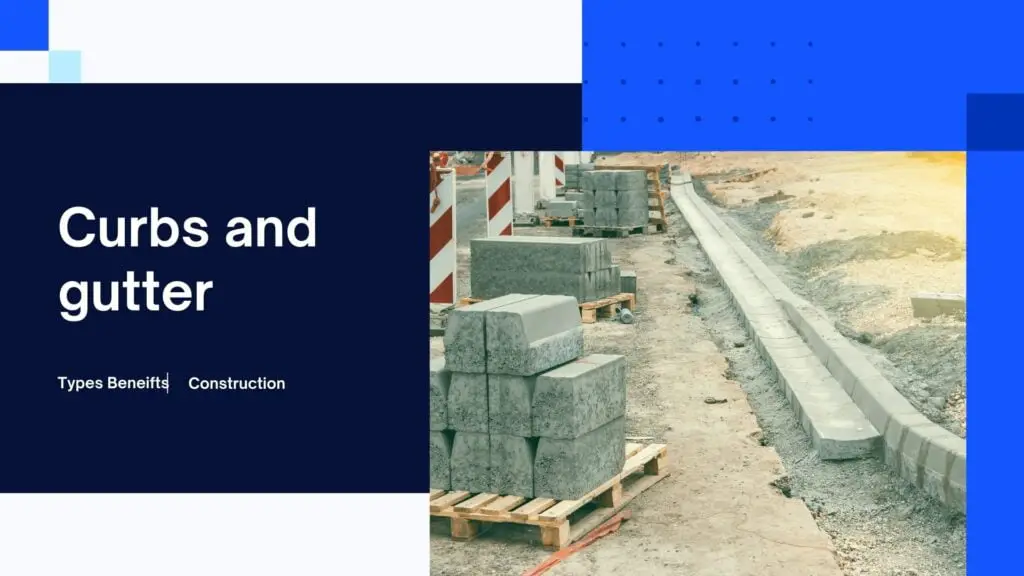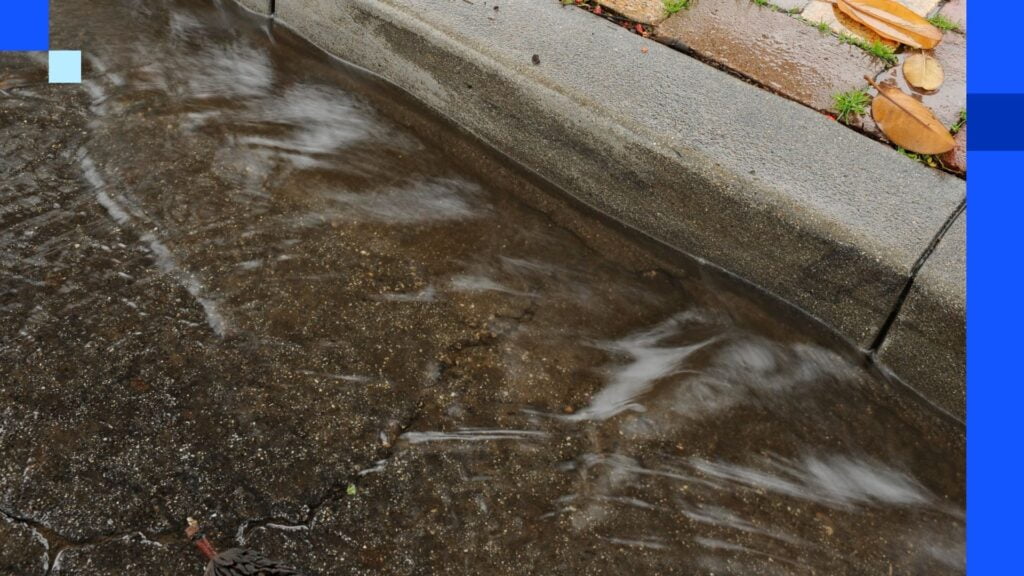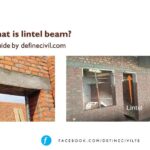When we think about the drainage of driveway, yard, or pavement, two important relevant structures are curbs and gutter. In fact, curbs and gutter is an important part of a roadway. But a lot of home
owners don’t know what does curb and gutter mean, or what some relevant details one must know are.
Well, the concept of Curb is also relevant to pavement and highway engineering. At the edge of a roadway or driveway, we can either provide a single curb or may be a combination of both i.e. curb and gutter.
A curb delineates the end of a road and act as a barrier between the street and the walkway or yard of a house. Sometimes, we cast curb with gutter, a flat concrete slab that helps in draining out surface water away from the walkway or yard. Curb and gutter can take different shapes and grades to suit the site requirements as well as the purpose.
Here’s everything you need to know about curbs and gutter:

Curb
A Curb is a small wall or barrier made of concrete or stone masonry which is provided at the edge of roads or embankment to keep the vehicles in a road carriageway. It prevents tipping of vehicles and protects passersby from vehicles running over.
You know what, in American English we spell it as Curb while in Australian or English standard we call it as Kerb, anyhow the meaning or purpose is same. The common application of curb is where roadway meets sidewalk, or walkway or where road meets median or central reservation.
Here’s the function of using curb:
- Curb and gutter delineates the edge of pavement, separating the road from sidewalk or walkway.
- It discourages drivers from parking their vehicles on walkways.
- Curb and gutter also prevents motorcyclists from driving on the walkways or lawns.
- Curb provide structural support to the pavement edge and so there’s no erosion of the road.
- By using curb and gutter, we can provide a channel for surface runoff from running to the side drains.
- They also elevate the aesthetic appeal of the roadway.
Gutter
A Gutter is a flat slab made of concrete or stone masonry at the edges of road and attached with curb. Purpose of providing gutter is road drainage.
Anyhow, sometimes we also provide gutter in roads as a separate. Most common is the use of steel gutters that act as a depression. The gutter runs parallel to a road and collects rainwater that flows along the street and divert that to the storm drain. The use of gutter is critical in the event of urban storms.
Curbs and gutter
A Curb and gutter are constructed together and act as a one unit. It reinforced the pavement edges by providing confinement and prevent damage at the edges which can occur due to repetition of loads and keep the vehicles on road. It removes the rainwater by draining through gutters provided along roads and prevent seepage of water in road layers.
Types of Curbs and Gutter
Curbs are classified based on its purpose, shape, and size. Most used are explained below.
Mountable curbs
Mountable curb is also known as roll curb, and it has sloping face which allow vehicles to move over them without damaging the tires and vehicles. The slope of mountable curb increases in constant manner and these types of curbs are provided at places where pedestrian wants to cross the road, Infront of shops, and those who are on bicycles and for roller skates to safely cross the road.

Mower Curbs
A Mower curb consists of combination of horizontal and sloping concrete curb used for residential and commercial projects. These are provided in lawns to separate the grassland and walkways or to separate the trees or plants area. These types of curbs are very decorative and widely used in lawn or flowerbed areas. The unique shape of this curb makes evenly cutting of grass without damaging the machinery.
Barrier Curbs
As the name suggests Barrier curbs are used to act as a barrier. Barrier curbs are raised vertical faces 6 to 9 inch high. These types of curbs are used along a road in a straight line. These curbs are made of concrete and are used to reinforce the pavement. It is used for parking lots and highways to prevent vehicles from accessing the highway at locations that are not permitted. It also helps vehicles to follow proper access locations and decrease chances of accidents.
Monolithic curbs
Monolithic curbs are also called integral curb which is provided along the roads, and they are fused together with the road pavement and act monolithically. The main benefit of using this type of curbs is that the durability of road surface increases and large, heavy vehicles can easily pass without damaging the pavement surface.
Slanted or slopping Curbs
Slanted curbs are also known as sloped curbs which is decreased slope on outer side. These types of curbs do not have any practical purpose. These are used for aesthetical and ornamental purposes. It is used to separate the road from yard or to separate the lawn tree or plants area from grassland.
Construction of Curb and Gutter
Setting out and Excavation
The first step involved in the construction of curbs and gutter is the marking of foundation of structure. The edges of roads where curbs and gutters are to be constructed are marked with powder. The necessary gradient is provided so that water from pavement flow towards gutter and gutter drained the water out of road to a drainage channel. Then marked area is excavated for construction of curbs.
Also Read: Hydrovac Excavation – The process- Benefits and Applications
Fixing formwork as per design
The next step after excavation is making of formwork for construction of curbs and gutter. The design of formwork depends upon size and shape of curb. Formwork is made with wood stakes and then driven into ground with hammer.
Placing concrete with compaction
After formwork the next step is placing of concrete of specified design mix for construction of curb and Gutter. The concrete is poured into curb area and then proper compaction is done to ensure a concrete of high density and to make concrete more durable.
Effective curing
Curing is the last and important step for obtaining concrete curbs of desired strength. After 15 hours when concrete become hard its curing period started and curing helps in attaining desired strength and reduces chances of shrinkage and cracks in curbs.
Also Read: Curing of Concrete – Methods – Temperature – Stages – Importance
Advantages of Curbs and Gutter
Support to road edges
The main benefit of curbs and gutter at road edges is that it reinforces the road pavement by providing confinement. In absence of curb due to heavy loading vehicles the edges of pavement will push towards the outlying dirt. It results in cracks on asphalt pavement. The water of rain will penetrate lower layers of pavement and weakens the layers. Curbs prevent the deterioration of pavement and provide support to the edges.
Drainage
Drainage water is one of the major causes of pavement failure after overloading. It decreases the design life of pavement. By providing curbs with gutter rainwater drained out of the road and flow towards drainage channel which protect pavement failure save large investment.
Reduces Road Accidents
Different types of curbs are used at road edges which act as a barrier on roads and highways which prevent vehicles from accessing the highways at locations where it is not permitted. As we know highways are high and fast traffic roads. So, providing these curbs reduces chances of accidents and increases safety of traffic.
Aesthetical purpose
Curbs are also used in house lawn or other commercial areas. It is also used in parking lots to define the parking boundary. In lawn it is used to separate grassland and pedestrian way. It increases the beauty of area.
Specification for curbs and gutter
(A) Vertical Curb to Be Used in Commercial Zones.
| Back wall of the curb in height | 12 inches |
| Curb top in width | 6 inches |
| Curb face in height | 6 inches |
| Curb face slope in six inches | 1/2 inch |
| Curb face and apron radius | 1 inch |
| Gutter width | 18 inches |
| Gutter thickness | 6 inches |
| (8) Gutter slope to curb face | 1 1/2 inches |
(B) Rolled Curb to Be Used in Residential Zones.
| Back wall of curb in height | 10 inches |
| Curb face height above flowline | 5 inches |
| Curb face slope | 12 inches |
| Gutter width | 18 inches |
| Gutter thickness | 6 inches |
| Gutter slope to curb face | 1 1/2 inches |



















